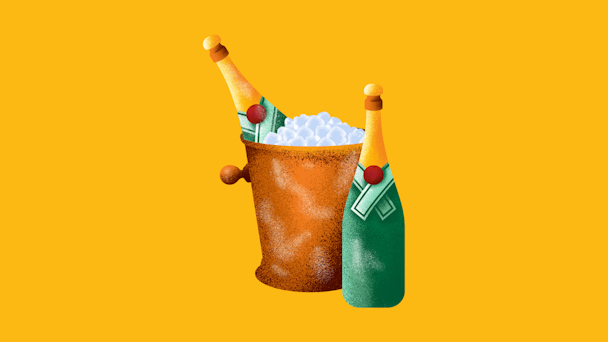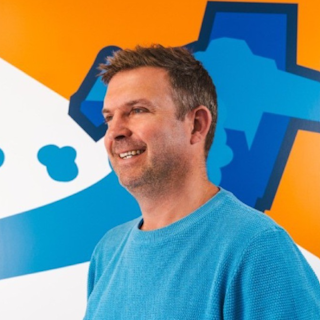How the masters of champagne made me rethink the 4Ps of marketing
In a previous life, Kwalee’s Harry Lang worked with champagne brands where he mostly chased freebies. They remained elusive, but these businesses changed his understanding of marketing.

Pitching a holiday in Epernay to Mrs Lang was one of the easier tasks. “There’s a street called Avenue de Champagne, with wall-to-wall chateaux, all offering tastings in a beautiful setting.” It was certainly more successful than my efforts to persuade her that our family needed a metal detector or the golf simulator.
But, I had an additional motive for visiting the Champagne region. In the early 2000s, I worked at a now-defunct agency (RIP, Bates 141). It had won the Allied Domecq business globally. As part of the onboarding team, I could choose which brands I account managed when the ‘meet and greet’ process was complete. Shunning the urban hip-ness of Courvoisier and the tropical ad shoots of Malibu, I opted for the champagne brands, namely the F1-associated Mumm and frankly stunning Perrier-Jouët. I wrongly thought I’d get to visit high-end London bars in the on-trade and receive work-funded trips to Epernay to see the fizz travel from grape to glass.
Advertisement
I was naive to agency protocol, so it genuinely surprised me when senior suits pulled rank and went on that chateaux crawl in France without me. I liberated a magnum from a photoshoot in revolt.
Fast forward a couple of decades, and it was time to make amends with my own trip, staying just outside Epernay for a holiday with family and friends. One of our pre-agreed rules was the introduction of ‘date days,’ whereby each couple would be driven to a venue of their choice, ‘sans infants,’ and picked up in a state of general merriment a few hours later. We chose the Avenue de Champagne, where my belated education in truly integrated marketing began.
The rules for our sojourn were simple – having already visited the divine Perrier-Jouët Maison on day one to exorcise some demons and gasp in wonder at the beauty of their Anemone-ensconced setup, we were only going to enjoy the hospitality of brands we’d never heard of, starting with De Venoge.
The Hôtel de Venoge, an astoundingly beautiful petit chateau halfway up the Avenue, was built in 1899 and was originally the family home of the wonderfully named Louis-Henri-Marcel Gallice, then president of the Champagne above House Perrier-Jouët. Since 2014, the house has been the HQ of Champagne House de Venoge. The DV brand picked a lane early on and stuck with it, using one of the most famous French icons to set itself apart. Its delicate glasses and bottles are shaped like the Eiffel Tower, which might sound gimmicky, but, in reality, it isn’t.
The Avenue de Champagne is more than just a street. It’s an infographic – a cobbled embodiment of brand hierarchy. At the foot of the hill lies the monster that is Moët & Chandon. A couple of beautiful chateaux act as fronts for architecturally significant, glass-fronted manufacturing and storage facilities belonging to Louis Vuitton Moët Hennessy, which owns six iconic Champagne brands, including Moët, Veuve Clicquot and Dom Pérignon. Add all the Moët Hennessy brands together, and you’ll get to an annual revenue of € 2.21bn.
Next door is the beautiful house of Perrier Jouet, my former client. All anemone flowers and Belle Epoque imagery, PJ is a design icon, and its Belle Epoque bottles, retailing at around £150, are a masterpiece before you even pop the cork.
A little further on, you’ll stumble into Ruinart, one of the first champagne houses dating from 1729. Its cellars and Pommery’s are in Gallo-Roman mines, meaning they go back nearly two millennia.
Further up, you’ll find Vranken-Pommery Monopole, the second-largest Champagne group, with revenues of € 218.8m. It owns five premium and super premium brands, including Vranken, Demoiselle, Charles Lafitte 183, Pommery and Heidsieck & Co. Monopole.
And this is the thing. The Avenue de Champagne is a visual metaphor – a literal graph of champagne houses based on age, size and revenue. Start of the hill = older/bigger/higher revenues, end of the hill = newer/smaller/lower revenues.
It’s so accurate as to be uncanny.
From LVMH-owned Moet, you can walk in a few minutes (maybe more if you stop. Which you should. Often) to the Chateau of Champagne Paul-Etienne Saint-Germain – the newest entrant to this exclusive promenade. Having spent his career working with the Daddies of the industry, including Veuve, Krug, Ruinart, Moet, and others, Jean-Michel and Agnès Lagneau risked it all to become the newest residents of this legendary Avenue just a few years ago.
I met Jean-Michel. He explained the blend of grapes. He brought the process to life. He passionately extrapolated the differences between his vintages and others. He sold us his dream. And he did this in order to sell us a twenty Euro tasting selection.
This entire street – no, the whole industry of Champagne – is built on this passion. It’s anticipation, it’s risk, it’s personal, it’s bad years – then more bad years. And then, maybe, a good year. It’s family. They struggle. They love what they make. And it shows.
Over the roundabout near the Lagneau’s Chateau, you’ll find an outlier where one shouldn’t be. An established, world-famous champagne house founded in 1858 by Eugène Mercier. He was an innovator in the truest sense. Needing a cool place to mature his Champagne, Eugène dug tunnels in the chalk under the Chateau–eighteen kilometers of them.
Advertisement
-
Needing a way to light his tunnels, he put in electric lights. The town of Epernay didn’t have electric lights in the 1890s, but Monsieur Mercier did.
-
Needing a more efficient way to turn his bottles, he invented a hydraulic bottle-turning device.
-
Needing a way to move his workforce around the tunnels every day, he installed an electric railway. It’s still there, ferrying awe-struck tourists between acres of bottles.
-
Needing a PR boost for the 1889 World’s Fair in Paris, he built a huge barrel with a capacity of 1,600 hectolitres and dragged it to the Capital by 24 oxen. Today, the barrel is on display in Mercier’s entrance hall.
-
He constructed a hot air balloon and took people up for a view of the Mercier vineyards.
Eugène Mercier was born from the mother of invention. He was a marketing genius who happened to be a Champagne wizard.
So, we have a case study of best practices for all marketers. The 4Ps are absolute, but beyond them, there are four more:
-
Personalization is embroidered into every visitor experience, from being charmed by owners to beautifully crafted follow-up emails thanking you for your purchase.
-
Passion waits in anticipation under every cork, ready to be freed in celebration by every customer. You sense it in every interaction, from the young waitress joyfully recounting the history of the Chateau to the ‘chef de cave’ pouring you a glass as she describes why each grape was selected.
-
Patience allows these luxury brands to do things properly, weather storms, celebrate the good, weather the bad and not take life too seriously.
-
And finally, Pride. Every blade of grass equals every glass sparkling, every building immaculate, every smile genuine. This isn’t a day job for those involved – it’s a personal mission to entertain, delight and astound.
The Avenue de Champagne should be on every marketer’s bucket list as a lesson in what perfection tastes like.
Harry Lang is VP of marketing at a game developer and publisher Kwalee and author of ‘Brands, Bandwagons & Bullshit,’ a guidebook for those starting their career in marketing, advertising, media and PR. You can find him at @MrHarryLang and connect with him on LinkedIn.

